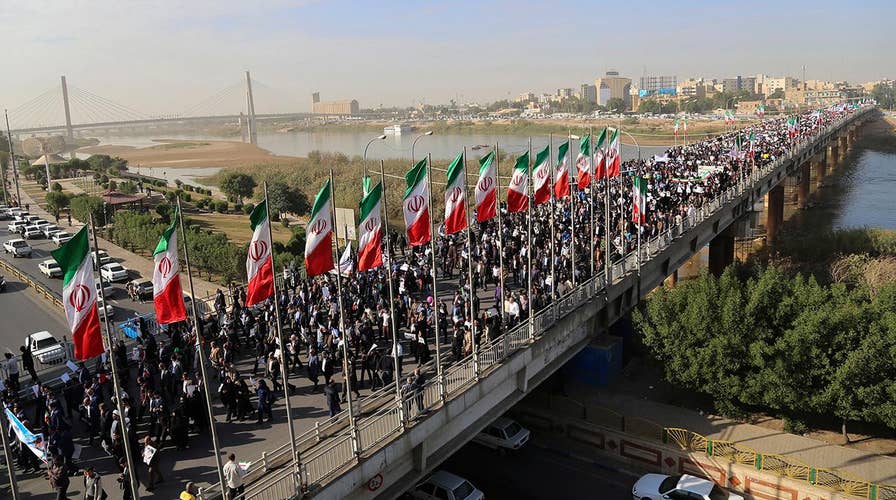Iran holds pro-government rallies to counter protests
The Trump administration continues to call for support of the uprising; Rich Edson has the story for 'Special Report.'
Iranian government representatives and many Western journalists based in the capital of Tehran are reporting that the wave of anti-government protest demonstrations that began on December 28 has died down. But protests continued Friday and all this week in Iran’s outer provinces, in both cities and rural areas among ethnic minorities. They could have enormous significance for the future of Iran.
The current protests are focused on a number of issues. But one motivation for the protests that has received little attention is the institutionalized discrimination against Iran’s ethnic minorities and the greater economic hardship in Iran’s periphery.
When the Soviet Union broke up into Russia and a host of smaller countries on its borders, the outer provinces that eventually became independent nations played a key role in the breakup.
We don’t know if the provincial protests in Iran will split that country, but they bear close watching.
While the economic situation in Iran challenges all its citizens, the residents of Iran’s periphery suffer greater hardship than residents of Iran’s center. Income levels in the periphery are lower than in Tehran, unemployment rates are higher and government-provided services are at a lower level.
In Iran, which is often referred to as Persia, ethnic Persians comprise only about half the population and are located mostly in Iran’s center. Iran’s periphery is populated mostly by ethnic minority groups: Azerbaijanis and Kurds in Iran’s northwest; Turkmen in the area of Mashad near the border with Turkmenistan; Baluch in the regions bordering Pakistan and Afghanistan; and Arabs in Iran’s southwest.
The Azerbaijanis are Iran’s largest minority group, comprising approximately one-third of the population, followed next by Iran’s Kurds.
The first protest demonstrations emerged in the city of Mashad. Western media described Mashad as a “holy city” due to the presence of the Iman Reza Shrine there, but did not focus on its large Turkmen population. From Mashad, the protests spread to the Kurdish and Arab provinces of Iran, not appearing in Tehran until the third day.
A map of the geographic locations of the protests illustrates where demonstrations have taken place border provinces. While the ultimate outcome of this wave of protests will be settled in Tehran, it’s important to note that the multiethnic composition of protests in other areas is a sign of the relative weakness of the government’s control in Iran’s border regions.
Some of the protestors are chanting slogans in minority languages and airing ethnic nationalist demands. On Friday one of the most provocative protests of the week took place during a soccer match in the city of Tabriz, in Iran’s East Azerbaijan province. Organized spectators called for Iranian Supreme Leader Ayatollah Ali Khamenei to resign and chanted ethnic slogans while live Iranian television broadcast the match as well as their protests.
Events in neighboring countries affect attitudes and developments among Iran’s ethnic minorities, since they share family and other ties with people of the same ethnicity in neighboring countries.
For example, the Iranian government’s actions – coordinated with the Iraqi government – to suppress Kurdish independence from Iraq have included military attacks on Kurds in Iraq, fueling indignation among Iran’s Kurdish citizens. The straddling of ethnic minorities across borders also complicates Iran’s foreign policy, since its relations with its neighbors have domestic ramifications.
Iran does not allow ethnic minorities to use their native languages in official settings, such as in courts and schools. And Iranian official media often ridicule Iran’s ethnic minorities, leading at times to anti-government protests.
While the economic situation in Iran challenges all its citizens, the residents of Iran’s periphery suffer greater hardship than residents of Iran’s center. Income levels in the periphery are lower than in Tehran, unemployment rates are higher and government-provided services are at a lower level.
In addition, some outlying provinces have suffered from extensive environmental pollution and degradation, sparking protests in recent years.
The current wave of protests centered in Iran’s periphery is not the first sign of recent opposition in Iran’s border provinces to the central government. In the last year, ethnic minorities carried out a number of terrorist attacks against state installations and members of the military. These include attacks in June by Iranian Kurds on the Iranian parliament and Khomeini Mausoleum, as well as frequent attacks on Iranian border guards in Iran’s northwest.
In any potential revolutionary situation, the critical factor affecting the outcome is the loyalty of the security and military services. In the provinces, locally based security services and police will be less likely to fire on members of their own communities than will the security services operating in Tehran and other large urban centers.
A crucial factor to watch will be if the Iranian regime moves security forces around different parts of the country to squash the protests. This would be more effective, but also would indicate that the rulers can’t count on local security forces to do the job in the provinces and suppress the demonstrators
The international media covering the protests in Iran need to travel outside Tehran and report the developments unfolding in the provinces to get a fuller picture of what is really going on in the country. If the protests escalate into a full-blown revolution – and no one knows if this will happen – the provinces could play a critical role.

